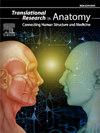Circle of Willis variations and features in an American Midwestern cadaver population
Q3 Medicine
引用次数: 0
Abstract
Background
The Circle of Willis (CoW) is a critical cerebral arterial network. This study investigates CoW variants in a Midwestern U.S. cadaveric population.
Methods
The CoWs of 25 formalin-fixed human cadavers were evaluated with vessel measurements obtained through ImageJ software. Variations were classified per a previously published system with R Studio statistical analysis, including comparisons by sex and body mass index (BMI).
Results
A typical CoW configuration was identified in 2 of 25 specimens (8 %), with the remaining 92 % demonstrating anatomical variants. The most common variations were unilateral hypoplasia (38.3 %), bilateral hypoplasia (21.3 %), and duplications (12.8 %). Variations most commonly involved the posterior communicating artery (73.9 %; PComA; especially PComA hypoplasia), the anterior communicating artery (60.9 %; AComA), and the anterior cerebral artery (52.2 %). Rare anatomical variants included quadruplication of the A2 segment, fetal-type PComA, and AComA aplasia.
Males exhibited significantly greater vessel diameters and lengths across most segments, except for PComA diameter, which was larger in females (p < 0.05). Non-overweight body mass index (BMI < 25) correlated positively with the diameter of the extra triplicated A2, and increased BMI ( ≥ 25) showed a significant increase in the right A1 ACA diameter (p < 0.05). No statistically significant differences were observed in arterial lengths.
Conclusions
This study highlights the high prevalence of CoW anatomical variations in the Midwestern population, including several distinctive variants, adding to the literature. Significant differences based on sex and BMI were identified, suggesting potential implications for neurosurgical and vascular surgery considerations. Further research with additional cohorts is necessary to validate and expand upon these observations.
美国中西部尸体人群的威利斯圈变异和特征
威利斯圈(CoW)是一个重要的脑动脉网络。本研究调查了美国中西部尸体人群中的奶牛变异。方法采用ImageJ软件对25具经福尔马林固定的人尸体进行血管测量。根据先前发布的R Studio统计分析系统对差异进行分类,包括性别和体重指数(BMI)的比较。结果25例标本中有2例(8%)鉴定出典型的奶牛构型,其余92%显示解剖变异。最常见的变异是单侧发育不全(38.3%)、双侧发育不全(21.3%)和重复(12.8%)。变异最常累及后交通动脉(73.9%;PComA;尤其是PComA发育不全),前交通动脉(60.9%;AComA)和大脑前动脉(52.2%)。罕见的解剖变异包括A2节段的四倍,胎儿型PComA和AComA发育不全。男性在大多数节段的血管直径和长度都明显更大,但PComA直径在女性中更大(p <;0.05)。非超重体重指数(BMI <;25)与额外三倍A2直径呈正相关,BMI≥25的增加显示右侧A1 ACA直径显著增加(p <;0.05)。动脉长度差异无统计学意义。本研究强调了中西部人群中奶牛解剖变异的高发性,包括几种不同的变异,为文献提供了补充。基于性别和BMI的显著差异被确定,提示神经外科和血管外科考虑的潜在影响。进一步的研究需要更多的队列来验证和扩展这些观察结果。
本文章由计算机程序翻译,如有差异,请以英文原文为准。
求助全文
约1分钟内获得全文
求助全文
来源期刊

Translational Research in Anatomy
Medicine-Anatomy
CiteScore
2.90
自引率
0.00%
发文量
71
审稿时长
25 days
期刊介绍:
Translational Research in Anatomy is an international peer-reviewed and open access journal that publishes high-quality original papers. Focusing on translational research, the journal aims to disseminate the knowledge that is gained in the basic science of anatomy and to apply it to the diagnosis and treatment of human pathology in order to improve individual patient well-being. Topics published in Translational Research in Anatomy include anatomy in all of its aspects, especially those that have application to other scientific disciplines including the health sciences: • gross anatomy • neuroanatomy • histology • immunohistochemistry • comparative anatomy • embryology • molecular biology • microscopic anatomy • forensics • imaging/radiology • medical education Priority will be given to studies that clearly articulate their relevance to the broader aspects of anatomy and how they can impact patient care.Strengthening the ties between morphological research and medicine will foster collaboration between anatomists and physicians. Therefore, Translational Research in Anatomy will serve as a platform for communication and understanding between the disciplines of anatomy and medicine and will aid in the dissemination of anatomical research. The journal accepts the following article types: 1. Review articles 2. Original research papers 3. New state-of-the-art methods of research in the field of anatomy including imaging, dissection methods, medical devices and quantitation 4. Education papers (teaching technologies/methods in medical education in anatomy) 5. Commentaries 6. Letters to the Editor 7. Selected conference papers 8. Case Reports
 求助内容:
求助内容: 应助结果提醒方式:
应助结果提醒方式:


